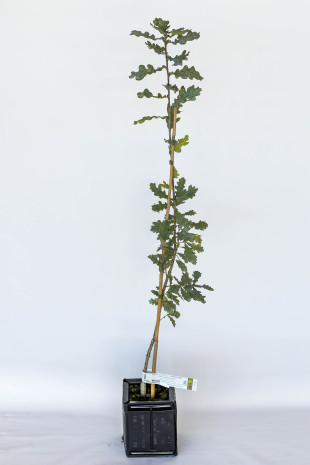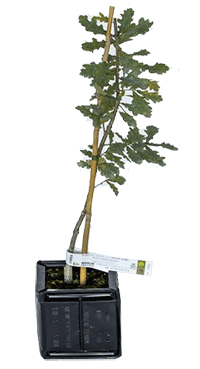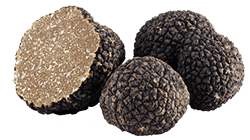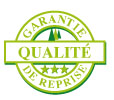


 Young truffle plant of Pedunculate Oak (Quercus pedonculata) mycorhized with tuber uncinatum. Pedunculate Oak intended for the production of Burgundy truffles. Truffle oak plant aged from 1 to 3 years, produced in France with certified quality under INRAE control.
Young truffle plant of Pedunculate Oak (Quercus pedonculata) mycorhized with tuber uncinatum. Pedunculate Oak intended for the production of Burgundy truffles. Truffle oak plant aged from 1 to 3 years, produced in France with certified quality under INRAE control.
Do you want to grow Burgundy truffles and are you looking for the most suitable plants for this production? Or perhaps you simply want to add new plants to your truffle orchard that will produce this famous autumn truffle appreciated for its taste? Because of its remarkable truffle-growing abilities, the pedunculate oak could be the ideal truffle plant for your truffle orchard!
 This pedunculate oak truffle plant is obtained after controlled and certified mycorrhization of a pedunculate oak tree (Quercus pedonculata) with Burgundy truffle spores (Tuber uncinatum). The tree obtained is ready to be planted in your truffle field. It will produce its first truffles within 6 to 7 years.
This pedunculate oak truffle plant is obtained after controlled and certified mycorrhization of a pedunculate oak tree (Quercus pedonculata) with Burgundy truffle spores (Tuber uncinatum). The tree obtained is ready to be planted in your truffle field. It will produce its first truffles within 6 to 7 years.
In order to meet your expectations, our pedunculate oak truffle plants, mycorhized with the Burgundy truffle, are available in 4 sizes of cups:
- in anti-chignon® R430 cup of 0.43 liters
- in anti-chignon® R600 cup of 0.6 liters
- in anti-chignon® R1.5L cup of 1.5 liters
- in R3L container (volume of 3 liters)
The pedunculate oak (Quercus pedonculata) is very present in the plains of all France (except the Mediterranean), Switzerland and Belgium. It thrives in fairly moderate and humid continental climates. Not very demanding, it prefers fresh and deep soils that remain humid all year long. However, the pedunculate oak needs warm summers. It tolerates drought as long as it is not excessively prolonged. Moreover, if it is moderately sensitive to winter cold, it fears late spring frosts, which explains why it is rarely found above 1300 m altitude. It is a heliophile species, which seeks full light. Its growth is slow in its youngest age then becomes more sustained. Depending on the biotope in which it is planted and the exposure from which it benefits, the pedunculate oak is able to favor the development of Tuber uncinatum, Tuber melanosporum and even Tuber magnatum.
 This is likely the most common edible truffle variety in Europe. This autumn truffle is distinguished by its black exterior (peridium). Inside, the flesh is dark brown. And it is distinguished by its very present white veins. The Burgundy truffle is an edible mushroom prized for its delicate flavors. As its vernacular name suggests, the Burgundy truffle was historically found mainly in east-central France. While it has since spread very widely well beyond this region, in France, Burgundy, Champagne, and Lorraine and Alsace remain the regions favored by Tuber uncinatum.
This is likely the most common edible truffle variety in Europe. This autumn truffle is distinguished by its black exterior (peridium). Inside, the flesh is dark brown. And it is distinguished by its very present white veins. The Burgundy truffle is an edible mushroom prized for its delicate flavors. As its vernacular name suggests, the Burgundy truffle was historically found mainly in east-central France. While it has since spread very widely well beyond this region, in France, Burgundy, Champagne, and Lorraine and Alsace remain the regions favored by Tuber uncinatum.
Our truffle oaks plants are produced in our laboratories under the control and license of INRAE. These plants are then pampered for many months in our nurseries. Quality plants, carefully selected, it is the guarantee to obtain a good yield after only a few years.
 The plants raised in ROBIN ANTI-CHIGNON® buckets are subject to a guarantee of recovery in the event of failure to recover more than 20% of the plants delivered. Under this guarantee, the seller undertakes to replace free of charge the defective plants during the season following the actual observation by the seller of the defective delivered plants.
The plants raised in ROBIN ANTI-CHIGNON® buckets are subject to a guarantee of recovery in the event of failure to recover more than 20% of the plants delivered. Under this guarantee, the seller undertakes to replace free of charge the defective plants during the season following the actual observation by the seller of the defective delivered plants.